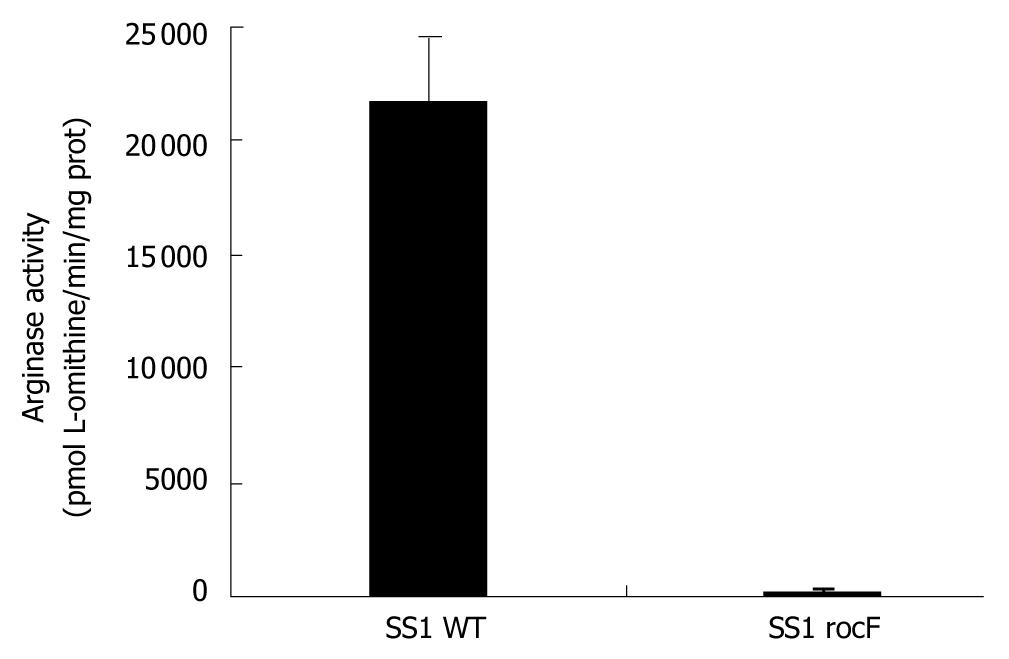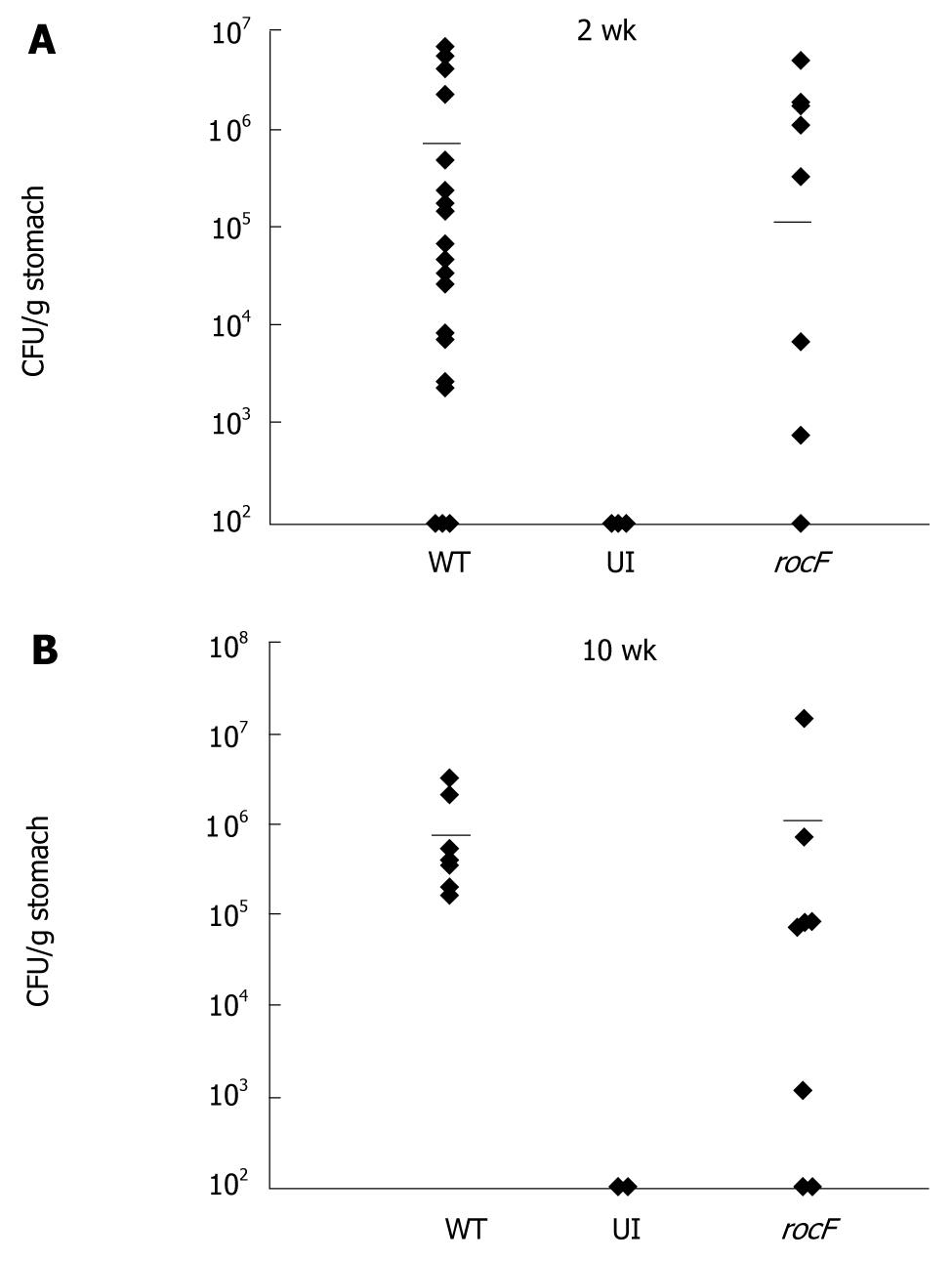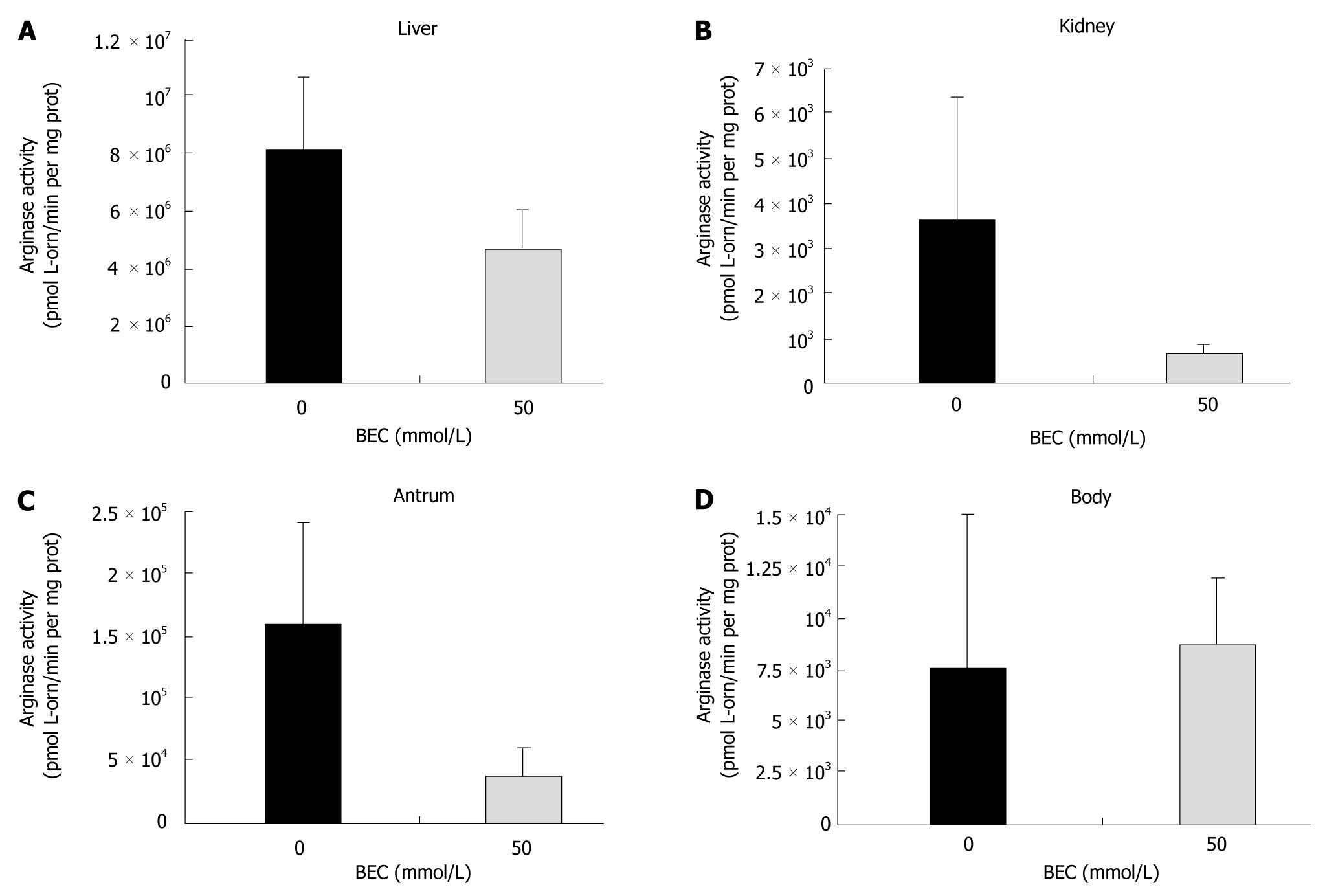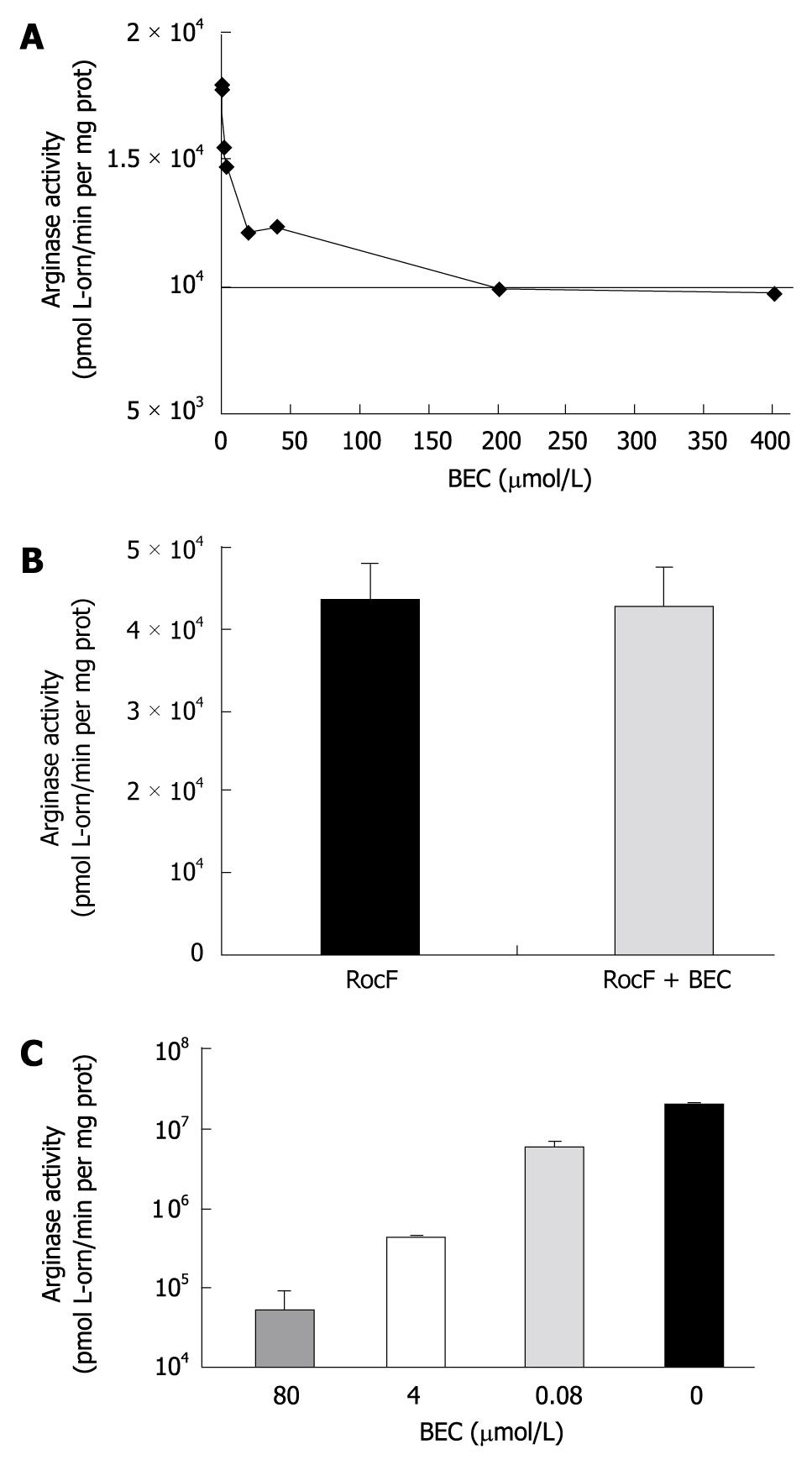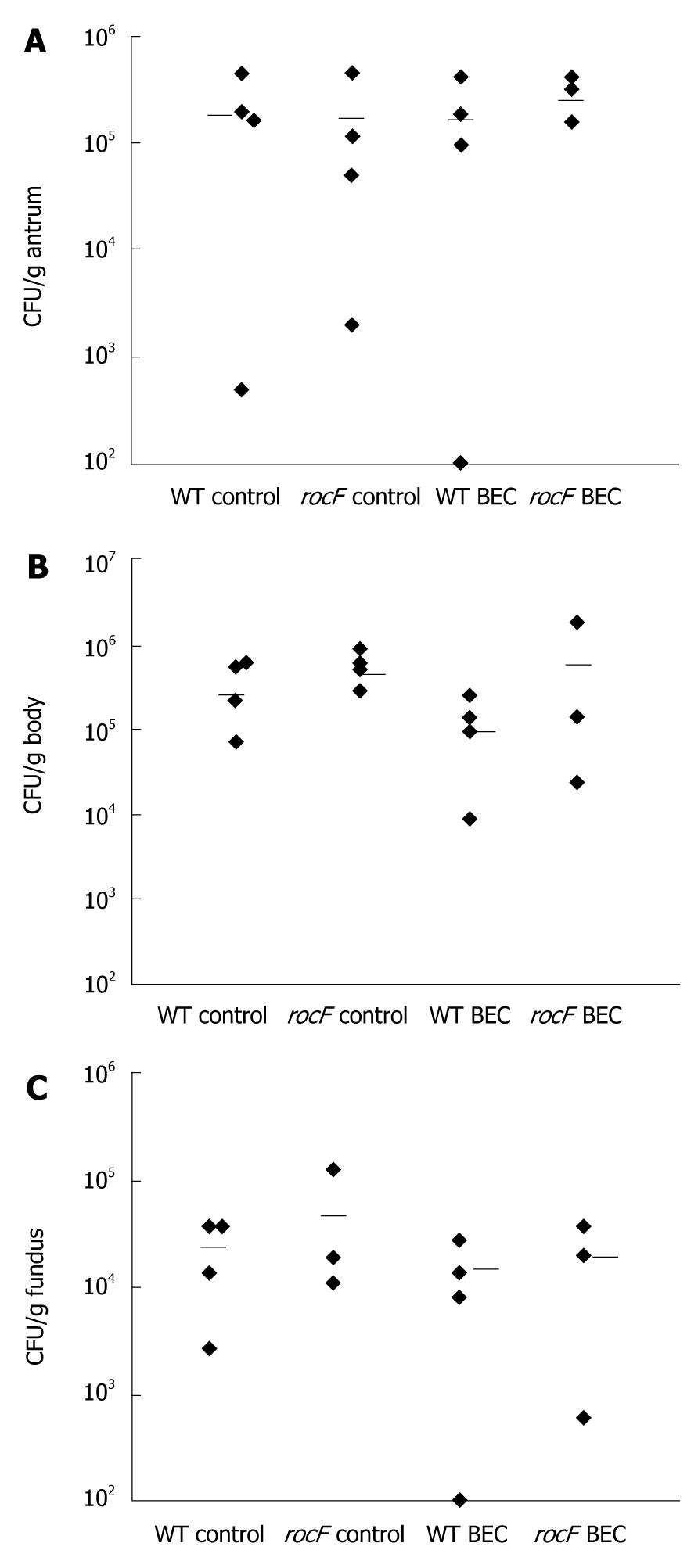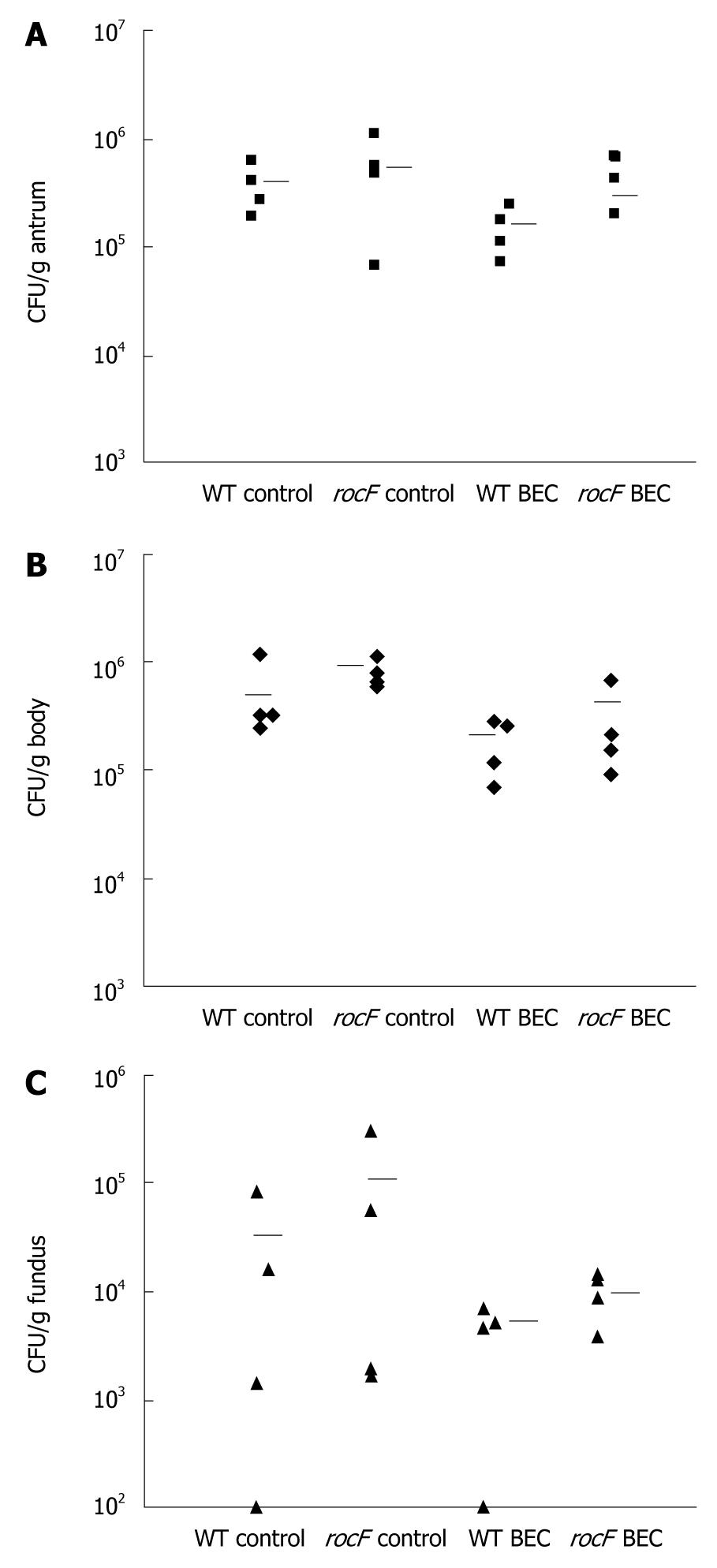Published online Jul 28, 2011. doi: 10.3748/wjg.v17.i28.3300
Revised: February 19, 2011
Accepted: February 26, 2011
Published online: July 28, 2011
AIM: To investigate the role of host and bacterial arginases in the colonization of mice by Helicobacter pylori (H. pylori).
METHODS: H. pylori produces a very powerful urease that hydrolyzes urea to carbon dioxide and ammonium, which neutralizes acid. Urease is absolutely essential to H. pylori pathogenesis; therefore, the urea substrate must be in ample supply for urease to work efficiently. The urea substrate is most likely provided by arginase activity, which hydrolyzes L-arginine to L-ornithine and urea. Previous work has demonstrated that H. pylori arginase is surprisingly not required for colonization of wild-type mice. Hence, another in vivo source of the critical urea substrate must exist. We hypothesized that the urea source was provided by host arginase II, since this enzyme is expressed in the stomach, and H. pylori has previously been shown to induce the expression of murine gastric arginase II. To test this hypothesis, wild-type and arginase (rocF) mutant H. pylori strain SS1 were inoculated into arginase II knockout mice.
RESULTS: Surprisingly, both the wild-type and rocF mutant bacteria still colonized arginase II knockout mice. Moreover, feeding arginase II knockout mice the host arginase inhibitor S-(2-boronoethyl)-L-cysteine (BEC), while inhibiting > 50% of the host arginase I activity in several tissues, did not block the ability of the rocF mutant H. pylori to colonize. In contrast, BEC poorly inhibited H. pylori arginase activity.
CONCLUSION: The in vivo source for the essential urea utilized by H. pylori urease is neither bacterial arginase nor host arginase II; instead, either residual host arginase I or agmatinase is probably responsible.
-
Citation: Kim SH, Langford ML, Boucher JL, Testerman TL, McGee DJ.
Helicobacter pylori arginase mutant colonizes arginase II knockout mice. World J Gastroenterol 2011; 17(28): 3300-3309 - URL: https://www.wjgnet.com/1007-9327/full/v17/i28/3300.htm
- DOI: https://dx.doi.org/10.3748/wjg.v17.i28.3300
Helicobacter pylori (H. pylori) causes gastritis[1-3], peptic ulcers[3], and is a significant risk factor for gastric adenocarcinoma[4]. Although the mechanisms behind this spectrum of diseases are not well understood, the very powerful bacterial urease is clearly central to pathogenesis[5-9]. Urease remains a key enzyme for diagnosing H. pylori infection[10].
Urease hydrolyzes urea to carbon dioxide (carbonic acid) and ammonium; the latter of which serves to protect the bacterium by neutralizing the acidic microenvironment[11]. Urease is the most abundant protein in H. pylori, and accounts for up to 10% of the total cellular protein[5]. It is assumed that urea, the substrate for urease, must be provided abundantly in vivo from either the bacterium or the host in order for urease to function efficiently (Figure 1). Indeed, the in vivo concentration of urea in the stomach is approximately 5 mmol/L[12,13], which is well above the Km for urease, and yet the in vivo source of the urea for H. pylori urease has remained unknown. It originally had been hypothesized that the urea comes from the bacterial arginase, RocF. Arginase catalyzes the hydrolysis of arginine to ornithine and urea (Figure 1). The surprising finding that arginase (rocF) mutants of H. pylori can still colonize mice suggests that another in vivo source of urea must exist[14]. The urea may come from direct release from gastric epithelial cells or other cells in gastric pits lining the stomach. Alternatively, the urea may diffuse into the gastric juice from the bloodstream. In either case, host arginases would be responsible.
We hypothesized that the host arginases are responsible for the urea that is needed by the H. pylori urease. There are two known host arginases: arginase I and arginase II. Arginase I is the cytoplasmic enzyme that is expressed heavily in the liver and at lower levels in a few other tissues, whereas arginase II is the mitochondrion-associated enzyme that is expressed in many tissues and cells, including the stomach, kidneys and macrophages[15]. Further support for a host-derived stomach source of arginase also comes from the findings that: (1) the arginase II gene is expressed in the stomach in mice and humans[16]; and (2) arginase immunohistochemistry staining is markedly elevated in human gastric cancer[17,18]. Both arginase I and arginase II knockout mice have become available[19,20]. Arginase I knockout mice have severe health problems and die between neonatal days 10 and 14[19], which makes it nearly impossible to use this model with H. pylori. In contrast, arginase II knockout mice have no reported overt health problems[20], although they appear to have reduced fecundity (McGee, unpublished observations).
Arginase II is expressed in the human and mouse stomach[16], therefore, we reasoned that the arginase II knockout mouse would allow us to determine the relative contributions of host versus bacterial arginase to colonization in vivo, through the production of urea. The rocF arginase mutant of H. pylori was included in this study in case the bacterial arginase became an important source of urea in the context of the arginase II knockout mice. Also, recent evidence has indicated that H. pylori induces murine and human gastric arginase II[16], which supports the logical choice of arginase II knockout mice as the ideal model for these experiments.
We infected wild-type or rocF mutant H. pylori into homozygous arginase II knockout mice to decipher whether bacterial or host arginase II was important for H. pylori colonization. To our surprise, the rocF mutant H. pylori colonized the arginase II knockout mice similar to wild-type mice, which suggests that the in vivo source of urea for H. pylori urease hydrolysis is from another pathway. Partial inhibition of host arginase I by the potent arginase inhibitor S-(2-boronoethyl)-L-cysteine (BEC)[21] still permitted colonization of the rocF mutant at or near wild-type levels in the arginase II knockout mice.
H. pylori strains SS1[22] and the isogenic rocF mutant[14] were routinely grown on Campylobacter agar (Becton Dickinson, Sparks, MD, USA) with 10% (v/v) sheep defibrinated blood (CBA; blood from Quad Five, Ryegate, MT, USA) for 2 d, using the CampyPak Plus system (Becton Dickinson), or in a humidified microaerobic atmosphere (5% O2, 10% CO2, and 85% N2). Kanamycin (10-15 μg/mL) was added as needed.
For mouse inoculation, wild-type SS1 and the isogenic rocF mutant were passaged an equal number of times from frozen stocks onto CBA. Strains were then grown overnight in a T 25 cm2 tissue culture flask without aeration in 5 mL Mueller-Hinton broth that contained 1% heatinactivated fetal bovine serum (FBS). Strains were then diluted 1:40 in 40 mL F-12 plus FBS (2%) in a T 75 cm2 tissue culture flask and allowed to grow for an additional 16-18 h at 37°C under microaerobic conditions. All strains grew equally well under these conditions and were inspected by light microscopy for motility and purity. Bacteria were harvested by centrifugation, washed with 1 × PBS (Invitrogen, Carlsbad, CA, USA), resuspended in 1 mL PBS, and used for inoculation of animals.
Arginase activity to detect ornithine production was determined as described previously[23] using a heat-activation step in the presence of 5 mmol/L cobalt chloride (H. pylori) or manganese chloride (mouse/rat) for 30 min at 50-55°C, followed by 1 h incubation at 37°C in arginase buffer [15 mmol/L MES (pH 6.0) plus 10 mmol/L L-arginine for H. pylori; 15 mmol/L Tris (pH 9.0) plus 10 mmol/L L-arginine for mouse or rat]. Absorbance at 515 nm was determined.
Enzymatically active H. pylori RocF was purified as a six-histidine-tagged fusion protein (His6-RocF) as described previously[23].
Plasmid pGEN222, kindly provided by Dr. Jim Galen (University of Maryland, Center for Vaccine Development)[24], was digested with Sal I and BamH I and the 1.1 kb rocF gene with its own promoter was excised from pBS-rocF[14] using the same enzymes. The ligated construct was transformed into Escherichia coli (E. coli) DH5α and confirmed by digestions and sequencing.
Rat arginase I
A plasmid carrying the rat arginase I gene, pARGr-2[25], kindly provided by Dr. Sid Morris (University of Pittsburgh), was transformed into E. coli DH5α, and plasmid extraction and restriction analysis showed that the construct was correct.
Mouse genotyping was similar to that described by Shi et al[20], with modifications described below. Chromosomal DNA was isolated from mouse ear (approximately 2 mm diameter) or tail snips using a lysis buffer (10 mmol/L Tris, pH 7.8, 75 mmol/L NaCl, 25 mmol/L EDTA pH 8.0, 1% SDS, 500 μg/mL Proteinase K) followed by phenol-chloroform extraction, ethanol precipitation, and elution in 10 mmol/L Tris/1 mmol/L EDTA, pH 8.0. This template was used in PCR with 200 pmol of each primer, 0.25 mmol/L dNTPs, and Taq DNA polymerase under the following conditions: 94°C, 5 min for one cycle; 94°C for 1 min, 53°C for 1 min, 72°C for 1 min for 35 cycles; and 72°C for 5 min. Primer sequences were as follows: DM52: 5'-TCCTTTCTCCTGTCTAATTC-3'; DM53: 5'-CTAGCATCTAATTGACTGCC-3'; DM54: 5'-CCATGATGGATACTTTCTC-3'. Expected product sizes were: DM 52/53 = 500 bp (wild-type mice); DM 52/54 = 870 bp (arginase knockout mice). Heterozygotes have both products.
This study was carried out in strict accordance with the recommendations in the Guide for the Care and Use of Laboratory Animals of the National Institutes of Health. All animal experiments were approved by the Institutional Animal Care and Use Committee at LSU Health Sciences Center-Shreveport (protocol # 06-020). Euthanasia was done by carbon dioxide asphyxiation. Arginase II knockout mice were initially bred from a homozygous knockout female and a heterozygous male generously provided by Dr. W O’Brien (Baylor College of Medicine, Houston, TX, USA). Offspring were genotyped and homozygous knockouts were retained for further breeding. Heterozygotes were euthanized from the colony. Male and female homozygous knockouts were used. The wild-type mice were C57BL/6 (Charles River Laboratories; ≥ 4 wk old), because homozygous wild-type littermates were euthanized from the breeding colony about 6 mo after the knockout line was established. Following the experiments, the breeding colony and all excess mice were euthanized due to insufficient resources.
Animals were inoculated orally (25-0 μL approximately 108-109 viable CFU/mL) with bacteria suspended in PBS (pH 7.4). Control animals received PBS. At various time points post-infection, animals were euthanized by cervical dislocation under anesthesia. Stomachs were removed, dissected longitudinally along the greater curvature, and the chyme removed. The rest of the stomach was usually dissected into antrum (distal region), body (middle region) and fundus/cardia (proximal region) portions, weighed, and homogenized (Ultra-Turrax T25, IKA Works, Inc; 10-15 s at a setting of 3) in 1.0 mL sterile PBS. There was insufficient stomach material to measure urea content. Stomach homogenates and dilutions thereof (serial 10-fold in 96-well microtiter dish) in PBS were plated for viable counts in duplicate on CBA plates that contained six antimicrobials to suppress normal flora as described previously[26]. H. pylori is resistant to these antimicrobials. Plates were incubated at 37°C for 5 d in a microaerobic atmosphere. Data are presented as CFU/g stomach or tissue section. Other organs were removed, weighed and homogenized in PBS, and assayed immediately for arginase activity.
BEC is a potent inhibitor of host arginases and was chemically synthesized according to published procedures[21]. BEC was given to animals (50 mmol/L) in the drinking water ad libitum, or directly given orally twice daily to mice (20 μL; approximately 50-100 μmol/L final concentration). BEC was also used in vitro for biochemical experiments.
Arginase and animal data were analyzed by unpaired, two-tailed t test, Welch corrected. P < 0.05 was considered significant. InStat software was used (GraphPad Software, San Diego, CA, USA).
Arginase I knockout mice breeding and genotyping
We received a heterozygous male and a homozygous female from the established arginase II knockout mouse breeding colony[20], therefore, we internally bred for the homozygous arginase II knockout mice and genotyped the offspring, similar to that described by Shi et al[20]. We successfully obtained homozygous arginase II knockout mice (Figure 2). Once the homozygous arginase II knockout line was firmly established, we euthanized all heterozygotes from the colony to ensure that no contamination occurred. The homozygous arginase II knockout mice were then periodically PCR confirmed for the knockout. Occasionally, we observed reduced fecundity with the arginase II knockout colony, although we did not pursue this.
Arginase activity, determined by ornithine detection in the presence of arginine, was measured from extracts of wild-type SS1 and the isogenic rocF mutant grown on CBA plates. No appreciable activity was detected in the mutant, in contrast with the wild-type strain, which had arginase activity (Figure 3). Omission of arginine led to no detectable ornithine, which showed that all of the ornithine that was detected was produced by arginine hydrolysis (data not shown). These results demonstrated that the rocF mutant of H. pylori had no arginase activity and did not appear to have alternative mechanisms of producing ornithine under these conditions. Using nuclear magnetic resonance, we have previously reported that the rocF mutant of SS1 has no arginase activity[14]. There is no evidence for the existence of an alternative urea-generating pathway in H. pylori, based on biochemical, genomics and metabolic networking approaches (McGee, unpublished observations)[27], but we cannot completely rule out this possibility.
Arginase IIknockout mice become infected with arginase mutant H. pylori
We have previously demonstrated that wild-type and rocF mutant H. pylori strain SS1 colonize wild-type mice[14]. To determine whether arginase II knockout mice were colonized by H. pylori, these mice were inoculated with wild-type or rocF mutant SS1 H. pylori. At 2 wk post-infection, there was a trend towards a 1 log10 decrease in colonization of the entire stomach by the rocF mutant compared with the wild-type strain, but this did not reach statistical significance (Figure 4A). By 10 wk post-infection, there was no difference in colonization between the wild-type and the rocF mutant (Figure 4B). We concluded that the rocF mutant devoid of arginase activity colonized arginase II knockout mice at or near the levels of the wild-type strain of H. pylori.
The experiment was repeated, but this time the antrum and body portions were separated, in order to understand whether there might be tropism differences. At 4 wk post-infection, the wild-type and rocF mutant both colonized the antrum and body regions of the stomach of arginase II knockout mice at similar levels (data not shown).
H. pylori wild-type and rocF mutant both induced similar levels of gastritis in the arginase II knockout mice (inflammatory score = 2.5 for wild-type; 2.5 for rocF mutant, four mice in each group).
The rocF mutant surprisingly colonized the arginase II knockout mice, yet the urea substrate must be available for H. pylori urease to function in vivo, therefore, we abandoned the hypothesis that arginase II generates the essential urea substrate for H. pylori urease. Instead, we reasoned that the source of the urea must originate from host arginase I. Arginase I knockout mice die at neonatal days 10-14, therefore, we could not test the role of arginase I directly. Thus, we used the host arginase inhibitor BEC. Preliminary experiments using different concentrations of BEC in mice suggested a concentration of 50 mmol/L would have at least some arginase inhibitory activity in the stomach (data not shown). The expense and concern of toxicity to the animals precluded using higher concentrations. Also, preliminary experiments that compared BEC given ad libitum in the drinking water versus twice daily by pipetting 20 μL of 50 mmol/L concentration directly into the oral cavity revealed that the latter gave more consistent inhibition of arginase activity (data not shown), and lower quantities of the inhibitor could be used. Thus, oral delivery was used for subsequent experiments.
To demonstrate that BEC inhibited arginase in vivo, we fed uninfected arginase II knockout mice with BEC by direct oral delivery to inhibit host arginase I. The data showed that exceptionally high levels of arginase activity occurred in the liver, as expected for the known location of highest expression of arginase I[15]. About 50% of this strong activity was inhibited by BEC (Figure 5A), which indicated that oral BEC delivery had a systemic effect on inhibiting arginase I activity. In the kidney, very low levels of arginase I activity were detected and this was reduced more than fivefold by BEC (Figure 5B). In the antrum region of the stomach, arginase I activity was intermediate to that of the liver or kidney and could be inhibited by more than threefold by BEC (Figure 5C). In contrast, in the body (Figure 5D) and the fundus (data not shown), BEC did not appreciably inhibit the arginase activity, although there was a lot of animal to animal variability. Arginase activity was also much lower in these other gastric regions than in the antrum. We conclude that BEC inhibits at least some of the arginase I activity in vivo, but residual activity still occurs.
If arginine was omitted from the enzyme buffer, no ornithine was detectable in the stomach (data not shown), which indicated that the tissues did not have appreciable amounts of pre-formed ornithine.
BEC does not inhibit H. pylori arginase activity, but does block arginase I activity
BEC is an established, potent eukaryotic arginase inhibitor with a Ki of 400-600 nmol/L[21], therefore, we questioned whether BEC would inhibit H. pylori arginase, which shares very limited amino acid homology with human arginases (data not shown). A BEC dose-response curve using extracts from E. coli that expressed the H. pylori rocF gene (Figure 6A) revealed only partial inhibition of H. pylori arginase activity at very high BEC concentrations (≥ 25 μmol/L). Even at 1000 times above the Ki for eukaryotic arginases, 400 μmol/L BEC only inhibited about 50% of the H. pylori activity. To show that this lack of inhibition was not due to the complexity of extracts, we purified the H. pylori arginase and tested whether BEC would inhibit H. pylori arginase activity. BEC used at the Ki for eukaryotic arginases (400 nmol/L) completely failed to inhibit H. pylori arginase activity (Figure 6B). To prove that the BEC was working properly under these conditions and also to show directly that BEC can inhibit arginase I in vitro, we used extracts from E. coli that expressed the rat arginase I. Rat and mice arginase I share 93% amino acid identity and 96% similarity (http://blast.ncbi.nlm.nih.gov/Blast.cgi), therefore, we assume that both enzymes behave in a similar fashion with respect to BEC inhibition. BEC was shown to inhibit 70% of the rat arginase I activity at just 80 nmol/L and > 97% at concentrations of ≥ 4 μmol/L (Figure 6C), which was in good agreement with the published Ki values[21]. These results show that BEC strongly inhibits eukaryotic arginase I under these enzyme assay conditions, yet BEC is a poor inhibitor of H. pylori arginase[21].
rocF mutant of H. pylori colonizes BEC-treated wild-type and arginase IIknockout mice
Wild-type or arginase II knockout mice were pretreated with BEC or water and inoculated with wild-type or rocF mutant H. pylori. Animals were euthanized at 1 wk post-infection. The rocF mutant of H. pylori colonized the BEC-treated wild-type mice (Figure 7). Remarkably, the rocF mutant also colonized BEC-treated arginase II knockout mice (Figure 8) at levels similar to wild-type H. pylori (P > 0.05). This similar colonization occurred in all three regions of the stomach (antrum, body and fundus). The experiment was repeated in the arginase II knockout mice alone (n = 5 or 6 mice per group), and only the antrum and body were processed. Essentially identical results were obtained (data not shown).
We demonstrated that the H. pylori rocF mutant, which has no detectable arginase activity, colonized host arginase II knockout mice. These data are very surprising, because host arginase II is expressed in the stomach, and is even upregulated by H. pylori infection[16]. Moreover, inhibiting at least some of the host arginase I by BEC treatment failed to block the ability of the rocF mutant to colonize arginase II knockout mice. The data suggest that H. pylori must obtain its urea from either the residual arginase I that is not inhibitable by BEC, or an alternative pathway of host urea generation, such as agmatinase. The data also suggest that enzymatically active host arginase I occurs in the stomach, as has also been suggested previously[28]. A recent study from Wilson and colleagues also have demonstrated that BEC inhibits murine macrophage arginase activity; this leads to an increase in nitric oxide production via increased host nitric oxide synthase protein in an arginine-dependent fashion when stimulated by H. pylori[29]. Gastric macrophages from H. pylori-infected arginase II knockout mice that had been given BEC in the drinking water did not produce more nitric oxide than macrophages from WT mice, which suggests that arginase II, but not arginase I is important for protection of H. pylori from nitric oxide[29]. Although arginase II clearly plays a crucial role in protection of H. pylori from nitric oxide, it is not essential for H. pylori colonization of the gastric mucosa, based on the findings reported here.
One other surprise in this study was a lack of substantial inhibition of H. pylori arginase by BEC. Only about 50% of the H. pylori arginase could be inhibited by very high concentrations of BEC. This finding may be due to the very distant evolutionary relationship between H. pylori and host arginases, as well as the finding that H. pylori arginase preferentially uses cobalt for enzyme activity[23] versus manganese for the host arginases. BEC is known to bind to eukaryotic arginases where the binuclear manganese center is situated[21], and perhaps the presence of cobalt in the H. pylori arginase weakens this inhibitory interaction. The very well conserved DAHAD divalent metal binding motif in eukaryotic arginases is completely conserved in H. pylori, which suggests that other amino acid residues in these proteins are responsible for the differential BEC inhibition observed between eukaryotic and H. pylori arginase.
The arginase from Bacillus anthracis (B. anthracis) has best catalytic activity with nickel[30]. Arginase activity from the purified B. anthracis RocF (active site = DAHGD) was not inhibited at all by up to 400 μmol/L BEC (assayed at pH 9.0), and instead, a stimulatory activity was noticed at 40 and 400 μmol/L BEC (Viator and McGee, unpublished observations). Whether the A to G amino acid substitution in the B. anthracis DAHGD metal-binding site is responsible for this lack of BEC inhibition is not yet known. Nonetheless, the data suggest that bacterial and eukaryotic arginases have distinct properties with respect to the BEC inhibitor.
The abundant urease must obtain copious amounts of urea for the urease to function efficiently in vivo, since urease is absolutely essential for colonization[8,9]. Urea is essential for urease activity, and urease is largely cytosolic in H. pylori, therefore, there must be a mechanism to transport urea. Indeed, the H. pylori UreI protein, expressed from the urease operon, is an urea transporter[31]. Mutation in ureI renders H. pylori attenuated in gerbils[32], which illustrates how crucial it is for urea to enter the bacterial cell and allow H. pylori to survive at pH < 4.0. Important future experiments are to examine the role of urease in more depth in this arginase II knockout mouse background, and to monitor closely intragastric pH and urea concentrations in the different stomach compartments in wild-type and arginase II knockout mice.
Although the data showed that BEC could almost completely inhibit arginase I in vitro, the same was not true in vivo. Several possibilities may account for this. First, oral delivery of BEC leads to the dilution of the inhibitor in the gastric juice, which could decrease its effective inhibitory concentration. Second, the acidity of gastric juice could alter inhibitory properties of BEC by protonation of BEC. This may explain why BEC inhibits arginase activity in the antrum, but not the body, where there is much stronger acid production. Third, BEC may not be able to enter the host cell with great efficiency to inhibit arginase I, which is found in the host cytosol. In the in vitro biochemical experiments, arginase is freed from the cells by a lysis step, which allows BEC direct access to the arginase. Finally, the complexities of the in vivo environment may lead to BEC being degraded or sequestered from reaching the arginase I . Despite these potential limitations it was demonstrated that oral delivery of BEC could block at least some of the arginase I in several tissues examined. However, the residual arginase I that remains may have been enough to provide the necessary urea substrate for H. pylori urease to utilize. Alternatively, another host urea-generating enzyme, agmatinase[33,34], may be responsible.
Agmatine is prevalent in the stomach[35,36] and 60% of this agmatine goes to the liver[37]. Interestingly, agmatine levels are higher in the gastric juice of H. pylori-infected patients versus uninfected patients[36]. Moreover, H. pylori has a putative arginine decarboxylase that could theoretically generate the agmatine. There is also the possibility that intestinal normal flora bacteria could provide the urea[38].
Future studies will center on attempting to eliminate host arginase I in the stomach. This may pose a challenge, due to the crucial role that arginase I plays in mice, which die of hyperammonemia shortly after birth if they are disrupted for arginase I[19]. Several possible strategies to inhibit completely host arginase I could be inhibitory RNA knockdown experiments, or construction of tissue-specific arginase I knockout mice that hopefully would live normally but just fail to produce arginase I in the stomach. However, urea could also diffuse to the stomach from arginine hydrolysis in other organs, which might complicate a tissue-specific arginase I knockout strategy. The recent study that used an arginase-containing adenovirus delivery system to complement the arginase I–/– mouse led to a doubling of survival to 27 d[39]. Further refinements to this exciting model may hold promise for additional exploration of the role of arginase I in H. pylori pathogenesis.
The in vivo source of urea still remains a mystery. However, it is clear that the in vivo source of urea for the crucial enzyme urease does not originate from the bacterial arginase or from host arginase II. Instead, the data suggest that urea originates from host arginase I or an alternative ureagenerating pathway.
The bacterium Helicobacter pylori (H. pylori) causes stomach problems, such as ulcers and inflammation and can lead to stomach cancer. One of the important proteins it makes that contributes to disease is called urease, an enzyme that converts urea to ammonia and carbon dioxide. Urease is required for bacteria to cause disease, and thus the substrate urea is also required. In this study, the authors designed experiments to determine from where this urea is coming: bacterial or host sources.
The most likely enzyme that provides the urea source is arginase and both H. pylori and humans have arginases (two in humans, one in H. pylori). The authors used a mouse model in which one of the arginases, arginase II, was knocked out, along with H. pylori wild-type or an arginase knockout bacterium (rocF). An arginase inhibitor called S-(2-boronoethyl)-L-cysteine (BEC) was also used to knock down the second mouse arginase (arginase I). The authors found that neither the bacterial arginase (rocF) nor arginase II from the mouse was important to provide the urea, which implies the involvement of either arginase I or another pathway (agmatinase).
The study provides the first steps towards the foundation needed to understand where the urea originates for the crucial urease enzyme. Much remains to be done, including completely knocking down arginase I in mice and determining whether another enzyme, agmatinase could be involved.
By understanding where the urea originates, the authors hope to develop novel anti-Helicobacter drugs. New therapies are sought because H. pylori is becoming resistant to antibiotics.
H. pylori causes infection in the stomach, which leads to inflammation, ulcers and cancer. Urease is an enzyme made by H. pylori the converts urea to ammonia and carbon dioxide. Arginase is an enzyme that converts arginine to ornithine and urea and is made by humans, mice and H. pylori. Knockout refers to a gene that is disrupted and no longer functional.
The authors found that the in vivo source for the essential urea substrate for the H. pylori urease is neither bacterial arginase nor host arginase II Based on these results, they hypothesized that either host urea-generating pathway such as agmatinase or the residual host arginase I might be responsible.
Peer reviewers: Shahinul Alam, Associate Professor, Department of Hepatology, BSM Medical University, House90. Road 9/A(New) 19 (Old). Dhanmobdi R/A, Dhaka 1000, Bangladesh; Janus P Ong, MD, Clinical Associate Professor, Section of Gastroenterology, Department of Medicine, Philippine General Hospital, Taft Avenue, Manila, Philippines; Ioannis Diamantis, MD, PhD, Professor, University of Athens Medical School, Department Internal Medicine, A. Tritsi 26 Gr-15238, Athens, Greece
S- Editor Sun H L- Editor Kerr C E- Editor Ma WH
| 1. | Blaser MJ. Gastric Campylobacter-like organisms, gastritis, and peptic ulcer disease. Gastroenterology. 1987;93:371-383. |
| 2. | Marshall BJ, Armstrong JA, McGechie DB, Glancy RJ. Attempt to fulfil Koch’s postulates for pyloric Campylobacter. Med J Aust. 1985;142:436-439. |
| 3. | Buck GE, Gourley WK, Lee WK, Subramanyam K, Latimer JM, DiNuzzo AR. Relation of Campylobacter pyloridis to gastritis and peptic ulcer. J Infect Dis. 1986;153:664-669. |
| 4. | Parsonnet J, Friedman GD, Vandersteen DP, Chang Y, Vogelman JH, Orentreich N, Sibley RK. Helicobacter pylori infection and the risk of gastric carcinoma. N Engl J Med. 1991;325:1127-1131. |
| 5. | McGee DJ, Mobley HL. Mechanisms of Helicobacter pylori infection: bacterial factors. Curr Top Microbiol Immunol. 1999;241:155-180. |
| 6. | McGee DJ, Mobley HL. Pathogenesis of Helicobacter pylori infection. Curr Opin Gastroenterol. 2000;16:24-31. |
| 7. | Mobley HL. The role of Helicobacter pylori urease in the pathogenesis of gastritis and peptic ulceration. Aliment Pharmacol Ther. 1996;10 Suppl 1:57-64. |
| 8. | Eaton KA, Brooks CL, Morgan DR, Krakowka S. Essential role of urease in pathogenesis of gastritis induced by Helicobacter pylori in gnotobiotic piglets. Infect Immun. 1991;59:2470-2475. |
| 9. | Eaton KA, Krakowka S. Effect of gastric pH on urease-dependent colonization of gnotobiotic piglets by Helicobacter pylori. Infect Immun. 1994;62:3604-3607. |
| 10. | Midolo P, Marshall BJ. Accurate diagnosis of Helicobacter pylori. Urease tests. Gastroenterol Clin North Am. 2000;29:871-878. |
| 11. | Marshall BJ, Barrett LJ, Prakash C, McCallum RW, Guerrant RL. Urea protects Helicobacter (Campylobacter) pylori from the bactericidal effect of acid. Gastroenterology. 1990;99:697-702. |
| 12. | Schreiber S, Konradt M, Groll C, Scheid P, Hanauer G, Werling HO, Josenhans C, Suerbaum S. The spatial orientation of Helicobacter pylori in the gastric mucus. Proc Natl Acad Sci USA. 2004;101:5024-5029. |
| 13. | Kim H, Park C, Jang WI, Lee KH, Kwon SO, Robey-Cafferty SS, Ro JY, Lee YB. The gastric juice urea and ammonia levels in patients with Campylobacter pylori. Am J Clin Pathol. 1990;94:187-191. |
| 14. | McGee DJ, Radcliff FJ, Mendz GL, Ferrero RL, Mobley HL. Helicobacter pylori rocF is required for arginase activity and acid protection in vitro but is not essential for colonization of mice or for urease activity. J Bacteriol. 1999;181:7314-7322. |
| 16. | Gobert AP, Cheng Y, Wang JY, Boucher JL, Iyer RK, Cederbaum SD, Casero RA, Newton JC, Wilson KT. Helicobacter pylori induces macrophage apoptosis by activation of arginase II. J Immunol. 2002;168:4692-4700. |
| 17. | Wu CW, Chi CW, Ho CK, Chien SL, Liu WY, P’eng FK, Wang SR. Effect of arginase on splenic killer cell activity in patients with gastric cancer. Dig Dis Sci. 1994;39:1107-1112. |
| 18. | Wu CW, Chung WW, Chi CW, Kao HL, Lui WY, P’eng FK, Wang SR. Immunohistochemical study of arginase in cancer of the stomach. Virchows Arch. 1996;428:325-331. |
| 19. | Iyer RK, Yoo PK, Kern RM, Rozengurt N, Tsoa R, O’Brien WE, Yu H, Grody WW, Cederbaum SD. Mouse model for human arginase deficiency. Mol Cell Biol. 2002;22:4491-4498. |
| 20. | Shi O, Morris SM, Zoghbi H, Porter CW, O’Brien WE. Generation of a mouse model for arginase II deficiency by targeted disruption of the arginase II gene. Mol Cell Biol. 2001;21:811-813. |
| 21. | Kim NN, Cox JD, Baggio RF, Emig FA, Mistry SK, Harper SL, Speicher DW, Morris SM, Ash DE, Traish A. Probing erectile function: S-(2-boronoethyl)-L-cysteine binds to arginase as a transition state analogue and enhances smooth muscle relaxation in human penile corpus cavernosum. Biochemistry. 2001;40:2678-2688. |
| 22. | Lee A, O’Rourke J, De Ungria MC, Robertson B, Daskalopoulos G, Dixon MF. A standardized mouse model of Helicobacter pylori infection: introducing the Sydney strain. Gastroenterology. 1997;112:1386-1397. |
| 23. | McGee DJ, Zabaleta J, Viator RJ, Testerman TL, Ochoa AC, Mendz GL. Purification and characterization of Helicobacter pylori arginase, RocF: unique features among the arginase superfamily. Eur J Biochem. 2004;271:1952-1962. |
| 24. | Galen JE, Nair J, Wang JY, Wasserman SS, Tanner MK, Sztein MB, Levine MM. Optimization of plasmid maintenance in the attenuated live vector vaccine strain Salmonella typhi CVD 908-htrA. Infect Immun. 1999;67:6424-6433. |
| 25. | Kawamoto S, Amaya Y, Murakami K, Tokunaga F, Iwanaga S, Kobayashi K, Saheki T, Kimura S, Mori M. Complete nucleotide sequence of cDNA and deduced amino acid sequence of rat liver arginase. J Biol Chem. 1987;262:6280-6283. |
| 26. | Langford ML, Zabaleta J, Ochoa AC, Testerman TL, McGee DJ. In vitro and in vivo complementation of the Helicobacter pylori arginase mutant using an intergenic chromosomal site. Helicobacter. 2006;11:477-493. |
| 27. | Schilling CH, Covert MW, Famili I, Church GM, Edwards JS, Palsson BO. Genome-scale metabolic model of Helicobacter pylori 26695. J Bacteriol. 2002;184:4582-4593. |
| 28. | Yu H, Yoo PK, Aguirre CC, Tsoa RW, Kern RM, Grody WW, Cederbaum SD, Iyer RK. Widespread expression of arginase I in mouse tissues. Biochemical and physiological implications. J Histochem Cytochem. 2003;51:1151-1160. |
| 29. | Lewis ND, Asim M, Barry DP, Singh K, de Sablet T, Boucher JL, Gobert AP, Chaturvedi R, Wilson KT. Arginase II restricts host defense to Helicobacter pylori by attenuating inducible nitric oxide synthase translation in macrophages. J Immunol. 2010;184:2572-2582. |
| 30. | Viator RJ, Rest RF, Hildebrandt E, McGee DJ. Characterization of Bacillus anthracis arginase: effects of pH, temperature, and cell viability on metal preference. BMC Biochem. 2008;9:15. |
| 31. | Weeks DL, Eskandari S, Scott DR, Sachs G. A H+-gated urea channel: the link between Helicobacter pylori urease and gastric colonization. Science. 2000;287:482-485. |
| 32. | Mollenhauer-Rektorschek M, Hanauer G, Sachs G, Melchers K. Expression of UreI is required for intragastric transit and colonization of gerbil gastric mucosa by Helicobacter pylori. Res Microbiol. 2002;153:659-666. |
| 33. | Morris SM. Vertebrate agmatinases: what role do they play in agmatine catabolism? Ann N Y Acad Sci. 2003;1009:30-33. |
| 34. | Uribe E, Salas M, Enríquez S, Orellana MS, Carvajal N. Cloning and functional expression of a rodent brain cDNA encoding a novel protein with agmatinase activity, but not belonging to the arginase family. Arch Biochem Biophys. 2007;461:146-150. |
| 35. | Steer H. The source of carbon dioxide for gastric acid production. Anat Rec (Hoboken). 2009;292:79-86. |
| 36. | Molderings GJ, Burian M, Homann J, Nilius M, Göthert M. Potential relevance of agmatine as a virulence factor of Helicobacter pylori. Dig Dis Sci. 1999;44:2397-2404. |
| 37. | Molderings GJ, Heinen A, Menzel S, Göthert M. Exposure of rat isolated stomach and rats in vivo to [(14)C]agmatine: accumulation in the stomach wall and distribution in various tissues. Fundam Clin Pharmacol. 2002;16:219-225. |
| 38. | Haenisch B, von Kügelgen I, Bönisch H, Göthert M, Sauerbruch T, Schepke M, Marklein G, Höfling K, Schröder D, Molderings GJ. Regulatory mechanisms underlying agmatine homeostasis in humans. Am J Physiol Gastrointest Liver Physiol. 2008;295:G1104-G1110. |











